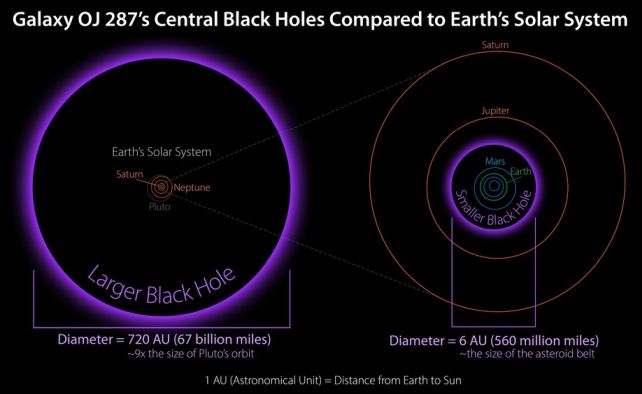The complex dance of two black holes locked in a doomed orbit has been revealed in a first-of-its-kind direct radio image.
This is the first time astronomers have directly imaged distinct jets from the two black holes in a known binary – finally confirming the double-core model of a galaxy called OJ 287.
In OJ 287, located approximately 3.5 billion light years away, the complex and extreme interaction between the two central supermassive black holes has been documented for decades. However, this is the first image to capture the smoldering signatures of both objects.
Related: Astronomers predict astonishing flare from two swirling supermassive black holes
“For the first time, we managed to obtain an image of two black holes rotating around each other. In the image, the black holes are identified by the intense particle jets they emit,” explains astronomer Mauri Valtonen from the University of Turku in Finland.
“Black holes themselves are perfectly black, but they can be detected by these jets of particles or by the glowing gas surrounding the hole.”
OJ 287 is a type of galaxy called a quasar, which happens to be the brightest object in the Universe. This brightness is fueled by the activity of the supermassive black hole located in their galactic center, actively feeding on a huge disk of material. As it swirls around the black hole, this material is heated by friction and gravity to extreme temperatures, causing it to glow with light.
However, OJ 287 is different from other quasars. As early as 1982, astronomers noticed a variability in its brightness, with a periodicity of 12 years, indicating the presence of a companion orbiting the central supermassive black hole, on a strange orbital trajectory that periodically crosses the disk.
“The unique thing about OJ287 is that it is thought to host not one but two black holes rotating around each other in a twelve-year orbit, which produces an easily recognizable pattern of light variations over the same period,” Valtonen explains.
Certain things can happen when black holes actively suck in matter. One is the eruption of astrophysical jets, when material from the innermost edge of the disk, closest to the black hole, is diverted along magnetic field lines outside the event horizon. When it reaches the poles, this matter is thrown into space at lightning speeds.

Previous observations of OJ 287 revealed a vast jet coming out of the larger of the two black holes, an absolute unit measuring 18 billion times the mass of the Sun. However, detection of a jet from the smaller of the two, with a more modest 150 million solar masses, has remained elusive.
Astronomers have made numerous observations of OJ 287, the most precise of which was obtained with a very long baseline interferometer, called RadioAstron, in 2014.
Working with Earth-based antennas, the space observatory achieved record resolution, spotting structures 3.5 billion light-years away, equivalent to imaging a coin on the surface of the Moon. The researchers believed that if a jet from the smaller black hole was detected, it would show up in the RadioAstron data.
So they returned to the RadioAstron map of the quasar light and identified several features associated with the astrophysical jet coming from a feeding black hole. They also calculated how the movement of the secondary black hole would change the trajectory of its jet.
Since the secondary black hole is moving much faster than the primary black hole, its spray should be twisted, like water coming from a spinning garden hose.

frameborder=”0″allow=”accelerometer; autoplay; write to clipboard; encrypted media; gyroscope; picture in picture; web sharing” referrerpolicy=”strict-origin-when-cross-origin”allowfullscreen>
Finally, the researchers compared the RadioAstron map and secondary jet trajectory calculations to previous models of binary black hole behavior. The results showed that one of the jet features on the map matched theoretical predictions about the secondary black hole jet almost perfectly.
In the image, the main jet crosses the galactic core diagonally, while a weaker, tilted trail matches the predicted path of the jet from the smaller black hole. Additionally, the Doppler properties of the jets suggest that the secondary jet moves slower, about half the speed of the primary jet.
This makes the RadioAstron images, obtained nearly a decade ago, the first evidence of two astrophysical jets, each emerging from a separate supermassive black hole.
The next step will be to check the result. Another OJ 287 radio card is currently under construction; this can reveal clues about the jet’s behavior. However, further observations may have to wait until the 2030s, when the secondary jet becomes visible again.
The team’s research was published in The Astrophysics Journal.









